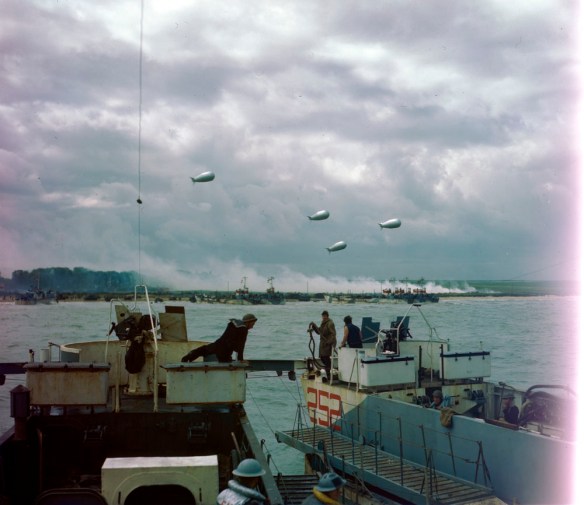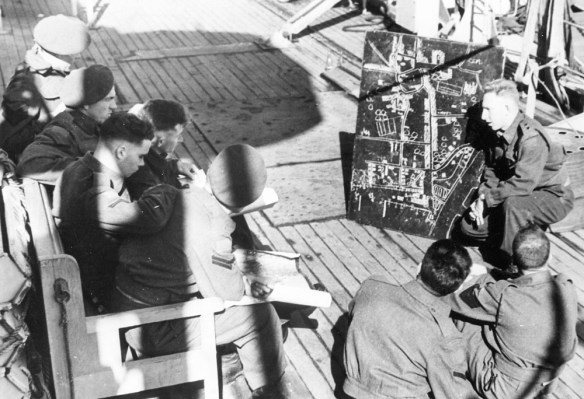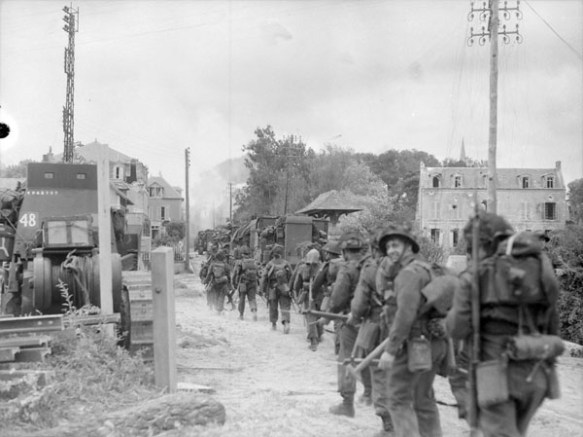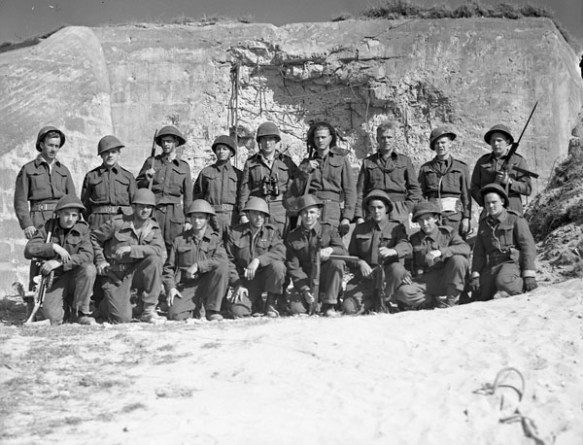By Alex Comber

Infantry landing craft at D-Day, June 6, 1944. (e010777287)
On this day 75 years ago, Canadian soldiers, sailors, pilots and aircrew were fighting in France in one of the largest military operations in history. Operation Neptune, or “D-Day,” was the first phase in the overall ground operations in Normandy, code-named “Operation Overlord.” Soldiers of the 3rd Canadian Infantry Division conducted an assault landing on a stretch of French coast, in the massive Allied effort to establish a new theatre of operations in Western Europe. Canadian units were tasked with creating a beachhead on a section of coast code-named Juno Beach. The assignment for Canadian forces was considered an honour, as the other four beaches, code-named “Utah,” “Omaha,” “Gold,” and “Sword,” were earmarked for landings by units of the powerful Allied members of the United States and Great Britain.

Lieutenant R.R. Smith briefing the non-commissioned officers of the Regina Rifles with a sketch of their objective, Courseulles-sur-Mer, France. (e011084119)
Senior Allied commanders and military planners at Supreme Headquarters Allied Expeditionary Force had learned from previous operations, such as the failure at Dieppe two years before, and the successful landings in Sicily in July 1943. This effort to open a new front in the war would benefit from a coordinated approach between land, sea, and air forces, along with comprehensive planning, attention to logistics, a massive build-up of equipment and personnel, feints and decoys to keep the enemy guessing, and a steady flow of accurate intelligence about enemy strengths and dispositions.
An armada of naval vessels escorted the invasion forces across the English Channel, while the airspace was controlled by squadrons of Allied aircraft. A vast array of specialized landing craft transported personnel, tanks, and artillery. In the Canadian sector, craft deposited men and equipment near the villages of Courseulles-sur-Mer, Bernières-sur-Mer, and Saint-Aubin-sur-Mer.

Canadian infantry going ashore at Bernières-sur-Mer in Normandy, France. (e010750646)
Tanks of the 2nd Canadian Armoured Brigade struggled ashore and began supporting the advancing infantry soldiers by firing on reinforced enemy positions, while some units of the Royal Canadian Artillery had already been bombarding enemy positions from their landing craft on the final approach. Hours earlier, paratroopers of the 1st Canadian Parachute Battalion had been dropped deep behind enemy lines as part of Operation Tonga, the airborne landings by the British 6th Airborne Division. Their mission was to destroy bridges, secure strongpoints, support a nearby attack by British paratroopers, and generally create chaos and hamper enemy efforts to counter-attack.

Private Tom J. Phelan, 1st Canadian Parachute Battalion, who was wounded at Le Mesnil on June 16, 1944, rides his airborne folding bicycle at the battalion’s reinforcement camp, England, 1944. (a204971)

Infantrymen of Le Régiment de la Chaudière moving through Bernières-sur-Mer, France, June 6, 1944. (a131436)
The fighting on the ground was accompanied by more involvement from Canadians serving in other forces. Pilots and aircrew flying with many Royal Canadian Air Force and Royal Air Force squadrons provided air cover for the naval operation and ground fighting, patrolled the coasts, attacked enemy troops and armour, provided photo-reconnaissance, and served on bombing missions to support the landings.

RCAF 440 Squadron members pose with a Hawker Typhoon in Normandy, France. (e010775786)
On D-Day, Royal Canadian Navy personnel served in more than 70 naval vessels (landing craft, destroyers bombarding the coast, and minesweepers clearing the way for the invasion forces). In early July, a naval Beach Commando unit went ashore to direct forces and maintain order on the invasion beaches.

Personnel of W-2 Party, Royal Canadian Navy Beach Commando “W” outside a German fortification in the Juno sector of the Normandy beachhead, France, July 20, 1944. (a180831)
The first Canadian boots on the ground in France would be joined by an entire army in mid-July. The First Canadian Army would become the largest formation of men and women in uniform in Canadian history. Bitter fighting continued as the Allied ground forces resisted counter-attacks and pushed inland. Canadian army units would gain objectives in operations at Carpiquet, around Caen, and advancing towards Falaise, but at great human cost.
Approximately 350 Canadian military personnel were killed during the D-Day landings. By the end of August, Canadian land, sea, and air forces had suffered about 5,000 fatalities as a result of operations in France, while many more were wounded. Operation Overlord closed in late August, as opposition crumbled in Normandy and surviving German units withdrew to regroup.

German personnel captured on D-Day embarking for England. (a132474)
Check back on July 4th to read Part two of LAC’s 75th Anniversary of D-day series, which will explore some of the unique collections LAC holds about these events.
Alex Comber is a Military Archivist in the Government Archives Division at Library and Archives Canada.

Pingback: A selection of records about D-Day and the Normandy Campaign, June 6 to August 30, 1944 – Active History
Pingback: D-Day remembered -
Reblogged this on battleoftheatlantic19391945 and commented:
”11/8/2022, AT 010:56-ANOTHER, more than precisely POSTING; CONCERNING VETERANS’ WEEK in Canada/November 7-11/2022, AND in REGARDS to Canada’s Army; DURING OPERATION OVERLORD/NEPTUNE…D-Day/OCCUPIED FRANCE ATTACK…June 6, 1944 TO August 30, 1944!!!”
”LEST WE FORGET, WE REMEMBER; OUR CANADIAN HEROES and HEROINES of THE SECOND WORLD WAR/W.W.II/1939-1945!!!”
”LOVE YOU ALL< OUR Canadian Glorious W.W.II Dead/Casualties; YOU ARE NOT FORGOTTEN…LOVE, Brian CANUCK Murza, W.W.II Naval Researcher-Published Author, Niagara Region, Ontario, Canada.''
”Blog credit: Mr. Alex COMBER.”